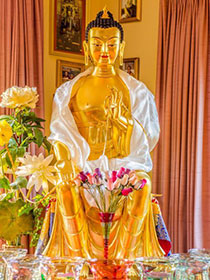- Home
- FPMT Homepage
Foundation for the Preservation of the Mahayana Tradition
The FPMT is an organization devoted to preserving and spreading Mahayana Buddhism worldwide by creating opportunities to listen, reflect, meditate, practice and actualize the unmistaken teachings of the Buddha and based on that experience spreading the Dharma to sentient beings. We provide integrated education through which people’s minds and hearts can be transformed into their highest potential for the benefit of others, inspired by an attitude of universal responsibility and service. We are committed to creating harmonious environments and helping all beings develop their full potential of infinite wisdom and compassion. Our organization is based on the Buddhist tradition of Lama Tsongkhapa of Tibet as taught to us by our founders Lama Thubten Yeshe and Lama Thubten Zopa Rinpoche.
- Willkommen
Die Stiftung zur Erhaltung der Mahayana Tradition (FPMT) ist eine Organisation, die sich weltweit für die Erhaltung und Verbreitung des Mahayana-Buddhismus einsetzt, indem sie Möglichkeiten schafft, den makellosen Lehren des Buddha zuzuhören, über sie zur reflektieren und zu meditieren und auf der Grundlage dieser Erfahrung das Dharma unter den Lebewesen zu verbreiten.
Wir bieten integrierte Schulungswege an, durch denen der Geist und das Herz der Menschen in ihr höchstes Potential verwandelt werden zum Wohl der anderen – inspiriert durch eine Haltung der universellen Verantwortung und dem Wunsch zu dienen. Wir haben uns verpflichtet, harmonische Umgebungen zu schaffen und allen Wesen zu helfen, ihr volles Potenzial unendlicher Weisheit und grenzenlosen Mitgefühls zu verwirklichen.
Unsere Organisation basiert auf der buddhistischen Tradition von Lama Tsongkhapa von Tibet, so wie sie uns von unseren Gründern Lama Thubten Yeshe und Lama Thubten Zopa Rinpoche gelehrt wird.
- Bienvenidos
La Fundación para la preservación de la tradición Mahayana (FPMT) es una organización que se dedica a preservar y difundir el budismo Mahayana en todo el mundo, creando oportunidades para escuchar, reflexionar, meditar, practicar y actualizar las enseñanzas inconfundibles de Buda y en base a esa experiencia difundir el Dharma a los seres.
Proporcionamos una educación integrada a través de la cual las mentes y los corazones de las personas se pueden transformar en su mayor potencial para el beneficio de los demás, inspirados por una actitud de responsabilidad y servicio universales. Estamos comprometidos a crear ambientes armoniosos y ayudar a todos los seres a desarrollar todo su potencial de infinita sabiduría y compasión.
Nuestra organización se basa en la tradición budista de Lama Tsongkhapa del Tíbet como nos lo enseñaron nuestros fundadores Lama Thubten Yeshe y Lama Zopa Rinpoche.
A continuación puede ver una lista de los centros y sus páginas web en su lengua preferida.
- Bienvenue
L’organisation de la FPMT a pour vocation la préservation et la diffusion du bouddhisme du mahayana dans le monde entier. Elle offre l’opportunité d’écouter, de réfléchir, de méditer, de pratiquer et de réaliser les enseignements excellents du Bouddha, pour ensuite transmettre le Dharma à tous les êtres. Nous proposons une formation intégrée grâce à laquelle le cœur et l’esprit de chacun peuvent accomplir leur potentiel le plus élevé pour le bien d’autrui, inspirés par le sens du service et une responsabilité universelle. Nous nous engageons à créer un environnement harmonieux et à aider tous les êtres à épanouir leur potentiel illimité de compassion et de sagesse. Notre organisation s’appuie sur la tradition guéloukpa de Lama Tsongkhapa du Tibet, telle qu’elle a été enseignée par nos fondateurs Lama Thoubtèn Yéshé et Lama Zopa Rinpoché.
Visitez le site de notre Editions Mahayana pour les traductions, conseils et nouvelles du Bureau international en français.
Voici une liste de centres et de leurs sites dans votre langue préférée
- Benvenuto
L’FPMT è un organizzazione il cui scopo è preservare e diffondere il Buddhismo Mahayana nel mondo, creando occasioni di ascolto, riflessione, meditazione e pratica dei perfetti insegnamenti del Buddha, al fine di attualizzare e diffondere il Dharma fra tutti gli esseri senzienti.
Offriamo un’educazione integrata, che può trasformare la mente e i cuori delle persone nel loro massimo potenziale, per il beneficio di tutti gli esseri, ispirati da un’attitudine di responsabilità universale e di servizio.
Il nostro obiettivo è quello di creare contesti armoniosi e aiutare tutti gli esseri a sviluppare in modo completo le proprie potenzialità di infinita saggezza e compassione.
La nostra organizzazione si basa sulla tradizione buddhista di Lama Tsongkhapa del Tibet, così come ci è stata insegnata dai nostri fondatori Lama Thubten Yeshe e Lama Zopa Rinpoche.
Di seguito potete trovare un elenco dei centri e dei loro siti nella lingua da voi prescelta.
- 欢迎 / 歡迎
简体中文
“护持大乘法脉基金会”( 英文简称:FPMT。全名:Foundation for the Preservation of the Mahayana Tradition) 是一个致力于护持和弘扬大乘佛法的国际佛教组织。我们提供听闻,思维,禅修,修行和实证佛陀无误教法的机会,以便让一切众生都能够享受佛法的指引和滋润。
我们全力创造和谐融洽的环境, 为人们提供解行并重的完整佛法教育,以便启发内在的环宇悲心及责任心,并开发内心所蕴藏的巨大潜能 — 无限的智慧与悲心 — 以便利益和服务一切有情。
FPMT的创办人是图腾耶喜喇嘛和喇嘛梭巴仁波切。我们所修习的是由两位上师所教导的,西藏喀巴大师的佛法传承。
繁體中文
護持大乘法脈基金會”( 英文簡稱:FPMT。全名:Found
ation for the Preservation of the Mahayana Tradition ) 是一個致力於護持和弘揚大乘佛法的國際佛教組織。我們提供聽聞, 思維,禪修,修行和實證佛陀無誤教法的機會,以便讓一切眾生都能 夠享受佛法的指引和滋潤。 我們全力創造和諧融洽的環境,
為人們提供解行並重的完整佛法教育,以便啟發內在的環宇悲心及責 任心,並開發內心所蘊藏的巨大潛能 — 無限的智慧與悲心 – – 以便利益和服務一切有情。 FPMT的創辦人是圖騰耶喜喇嘛和喇嘛梭巴仁波切。
我們所修習的是由兩位上師所教導的,西藏喀巴大師的佛法傳承。 察看道场信息:
- FPMT Homepage
- News/Media
-
- Study & Practice
-
-
- About FPMT Education Services
- Latest News
- Programs
- New to Buddhism?
- Buddhist Mind Science: Activating Your Potential
- Heart Advice for Death and Dying
- Discovering Buddhism
- Living in the Path
- Exploring Buddhism
- FPMT Basic Program
- FPMT Masters Program
- FPMT In-Depth Meditation Training
- Maitripa College
- Lotsawa Rinchen Zangpo Translator Program
- Universal Education for Compassion & Wisdom
- Online Learning Center
-
- Prayers & Practice Materials
- Overview of Prayers & Practices
- Full Catalogue of Prayers & Practice Materials
- Explore Popular Topics
- Benefiting Animals
- Chenrezig Resources
- Death & Dying Resources
- Lama Chopa (Guru Puja)
- Lama Zopa Rinpoche: Compendium of Precious Instructions
- Lama Zopa Rinpoche: Life Practice Advice
- Lama Zopa Rinpoche Practice Series
- Lamrim Resources
- Mantras
- Prayer Book Updates
- Purification Practices
- Sutras
- Thought Transformation (Lojong)
- Audio Materials
- Dharma Dates - Tibetan Calendar
- Translation Services
- Publishing Services
- Ways to Offer Support
- Prayers & Practice Materials
-
- Teachings and Advice
- Find Teachings and Advice
- Lama Zopa Rinpoche Advice Page
- Lama Zopa Rinpoche: Compendium of Precious Instructions
- Lama Zopa Rinpoche Video Teachings
- ༧སྐྱབས་རྗེ་བཟོད་པ་རིན་པོ་ཆེ་མཆོག་ནས་སྩལ་བའི་བཀའ་སློབ་བརྙན་འཕྲིན།
- Podcasts
- Lama Yeshe Wisdom Archive
- Buddhism FAQ
- Dharma for Young People
- Resources on Holy Objects
- Teachings and Advice
-
-
*If a menu item has a submenu clicking once will expand the menu clicking twice will open the page.
-
-
- Centers
-
- Teachers
-
- Projects
-
-
-
-
*If a menu item has a submenu clicking once will expand the menu clicking twice will open the page.
-
-
- FPMT
-
-
-
-
-
My religion is kindness to all
His Holiness the Dalai Lama
-
-
-
- Shop
-
-
-
The Foundation Store is FPMT’s online shop and features a vast selection of Buddhist study and practice materials written or recommended by our lineage gurus. These items include homestudy programs, prayers and practices in PDF or eBook format, materials for children, and other resources to support practitioners.
Items displayed in the shop are made available for Dharma practice and educational purposes, and never for the purpose of profiting from their sale. Please read FPMT Foundation Store Policy Regarding Dharma Items for more information.
-
-
Lama Zopa Rinpoche News and Advice
2
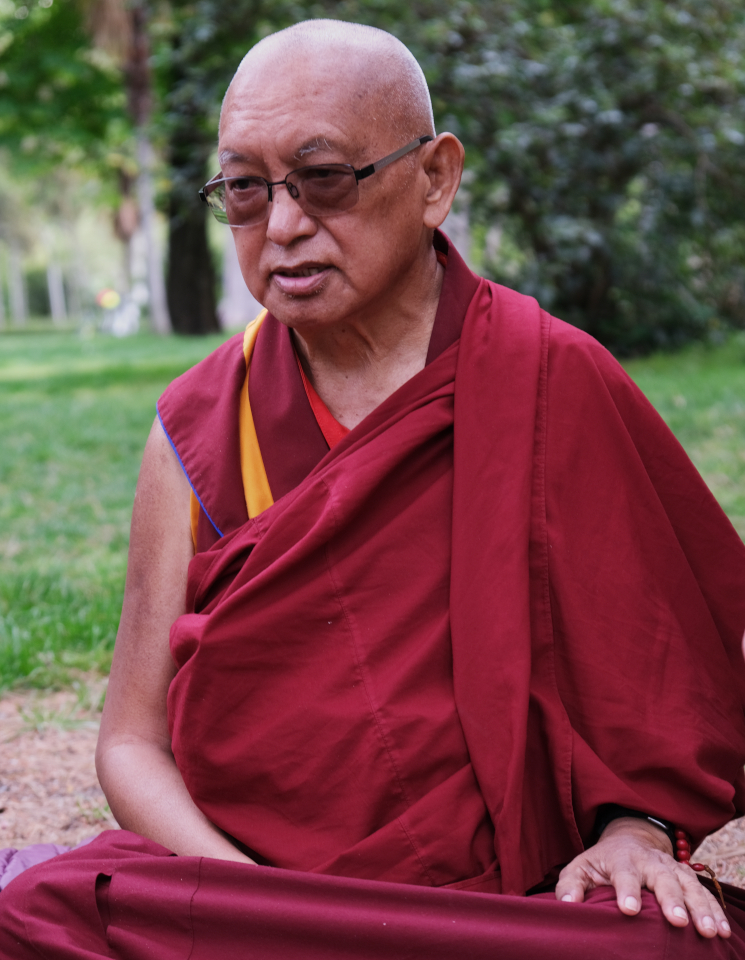
Lama Zopa Rinpoche doing prayers in El Retiro Park, Madrid, Spain, April 2019. Photo by Ven. Roger Kunsang.
While teaching in Madrid, Spain, in October 2018, Lama Zopa Rinpoche gave an introduction to thought transformation and explained its benefits, captured in the thirty-minute video below.
Thought transformation, Lama Zopa Rinpoche said, is about “how to utilize your problems, including death, sicknesses, whatever—something that you don’t like, something that your self-cherishing thoughts do not like, does not wish for, or your attachment doesn’t want—you are using that in the path to enlightenment. If you are experiencing obstacles to practicing Dharma, you utilize the obstacles in the path to enlightenment, to achieve enlightenment quicker.
“You use that for every sentient beings, every hell being, every hungry ghost, every animal, every animal living in the ocean; numberless beings, the biggest the size of mountains, then the smallest, I don’t remember their name; those living in the bushes, the grass, the trees, the sky; then numberless human beings living in numberless universes; then numberless sura beings, asura beings. You use your problems in the path for every sentient being to achieve enlightenment quickly.
“So in this way you have no obstacle to practicing Dharma. Whatever is an obstacle, you utilize in the path to enlightenment.”
Rinpoche pointed out another benefit of training your mind in this way: “Your mind, your mental continuum, becomes so soft. Your mental continuum is not rough, but it becomes very soft, like soft cotton.
“By sitting next to a person who practices this, even without talking, just sitting, you feel that the person’s heart, their mind, is so soft, so subdued, so good-hearted, so warm with loving kindness and compassion. You can feel that, even without talking, just sitting next to the person, you can feel that.”
Rinpoche then recalled how happy participants were to meet and receive teachings from Lama Yeshe during their first visit to Australia. This was due to Lama Yeshe’s warm-heartedness and wisdom.
With the practice of thought transformation, Rinpoche concluded, you are not afraid of anything, not even cancer or death, as any obstacle turns into a chance to train the mind.
Watch a thirty-minute video of Lama Zopa Rinpoche teaching on mind training:
https://youtu.be/jB7KPZNtPxU
Quotations excerpted from Lama Zopa Rinpoche teaching in Madrid, Spain, October 20, 2018. Simultaneously transcribed by Ven. Joan Nicell. Lightly edited by Laura Miller, August 2019. (Find the complete unedited transcript here.)
Watch more short videos from Lama Zopa Rinpoche’s recent teachings:
https://fpmt.org/media/streaming/teachings-of-lama-zopa-rinpoche/
Find complete videos of Lama Zopa Rinpoche’s recent teachings:
https://fpmt.org/media/streaming/teachings-of-lama-zopa-rinpoche/
Lama Zopa Rinpoche is the spiritual director of the Foundation for the Preservation of Mahayana Tradition (FPMT), a Tibetan Buddhist organization dedicated to the transmission of the Mahayana Buddhist tradition and values worldwide through teaching, meditation and community service.
- Tagged: lama yeshe, lama zopa rinpoche, lojong, mind training, video
26
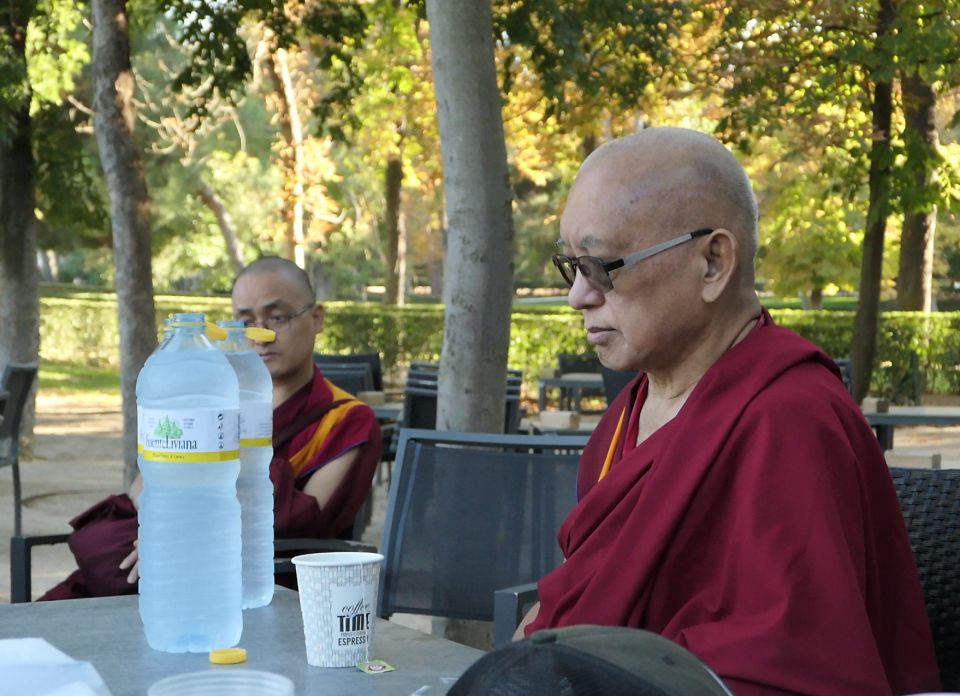
Lama Zopa Rinpoche blessing water to put in a city park pond to bless the fish and ducks in the pond, Madrid, Spain, October 2018. Photo by Ven. Roger Kunsang.
While teaching in Madrid, Spain, in October 2018, Rinpoche summarized the whole path to enlightenment, emphasizing the importance of the guru. The path also includes developing renunciation, bodhichitta, and an understanding of gross and subtle emptiness, and eventually practicing tantra. Here’s part of this teaching:
When your mind is living in correctly following the virtuous friend, realizing this, you are looking at each guru as all the buddhas, buddhas’ dharmakaya. You are not only looking with devotion and following with devotion, but your actions are fulfilling the wishes and following the advice of the guru.
Each time you follow what the guru advises you, for example, even reciting mantras—each day reciting two thousand or one thousand OM MANI PADME HUM—then each time you recite OM MANI PADME HUM, you become closer to enlightenment. You become closer to enlightenment by reciting OM MANI PADME HUM one time. The guru gave advice to recite every day one thousand mala or two thousand mala, so each time you recite OM MANI PADME HUM, you become closer to enlightenment, closer to being free from samsara, you understand? Then also the number of vows that have been given to you, as you follow the advice, each day, each hour, each minute, you become closer to being free from samsara and closer to enlightenment.
Like Milarepa, even when you are just so busy doing work, for example you are manager or you are a builder or something, but due to the guru’s advice, you are all the time working with the people, talking with the people, walking up and down, with each step you fulfill the guru’s advice and wishes. Then with each step, each action at work you do, you are collecting the most unbelievable merits and purification. Then you’ll more quickly be free from samsara and more quickly achieve enlightenment with each step, each talk you do, because it is according to the guru’s advice, fulfilling the guru’s wishes. When you are talking to the people, workers, it is like that.
Wow, wow, wow. Then you can realize how you are most fortunate. Otherwise you think you are just given work, work, work. …
Hear more from Rinpoche on following the guru and the path to enlightenment in this 12-minute video teaching:
https://youtu.be/FWUN-E2N-2M
Colophon: Excerpted from Lama Zopa Rinpoche teaching in Madrid, Spain, October 28, 2018. Simultaneously transcribed by Ven. Joan Nicell. Lightly edited by Laura Miller, July 2019. (Complete unedited transcript here.)
Find complete videos of Lama Zopa Rinpoche’s recent teachings, including teachings from the May-June 2019 Vajrayogini retreat at Institut Vajra Yogini in France:
https://fpmt.org/media/streaming/teachings-of-lama-zopa-rinpoche/
Lama Zopa Rinpoche is the spiritual director of the Foundation for the Preservation of Mahayana Tradition (FPMT), a Tibetan Buddhist organization dedicated to the transmission of the Mahayana Buddhist tradition and values worldwide through teaching, meditation and community service.
- Tagged: essential extract, guru devotion, lama zopa rinpoche, lamrim, video
12

Lama Zopa Rinpoche teaching during the November Course, Kopan Monastery, December 2018. Photo by Ven. Lobsang Sherab.
During the 2018 November Course at Kopan Monastery, Lama Zopa Rinpoche outlined how to reach enlightenment based on the lamrim and the importance of studying it. Rinpoche emphasized that merely knowing the lamrim is not enough; it needs to be applied in daily life. Here’s an excerpt from Rinpoche’s teachings.
Practice mindfulness and the three principal aspects of the path to enlightenment—renunciation, bodhichitta, and right view. Then everything done with renunciation becomes the cause of liberation and does not become the cause of samsara. Then everything done with bodhichitta becomes the cause of enlightenment. Then with right view, everything becomes a remedy to samsara, a remedy to ignorance, which is the root of all your suffering, your samsara, the root of all your sufferings of samsara. It eliminates that; that’s what you need.
If you don’t like suffering, you have to put in effort to actualize emptiness, if you don’t like suffering. If you don’t like depression, if you don’t like any suffering, even diarrhea, whatever you don’t like, then you need to meditate on emptiness, and in particular you have to put effort into realizing emptiness. Study emptiness, all the extensive philosophy teachings, then lamrim, the essence, the short teachings, very important teachings.
You need to not only study—you leave it up to the intellect, you leave it up to the tape recorder, you invest so much information, you put in a tape recorder or computer—not like that. You invest in your brain so much information, but no practice, you only discuss, only to be an important professor—not like that. You need to actualize. So everything becomes practice, and through practice, you actualize. Everything becomes the antidote to your samsara, to your ignorance, which is the root of your samsara. So it eliminates the root of oceans of suffering of samsara. That’s what you need. If you don’t like suffering, you need to put effort in that. It’s extremely worthwhile.
Not only that, not only to free yourself from oceans of suffering of samsara, not only that, but with the help of bodhichitta, you collect inconceivable, inconceivable, inconceivable merits, with that support. Then with the wisdom realizing emptiness, you directly cease the obscuration, not only gross but subtle obscuration. Then you achieve enlightenment for sentient beings, and you are able to liberate all sentient beings from oceans of samsaric sufferings and bring everyone to buddhahood.
If you don’t like suffering, if you have problems—a relationship problem, a problem with the family, with the husband, with the wife or children, with friends, whatever—you should know that. The antidote—to be free from the suffering of samsara—you need to be free from delusion and karma; you need to be free from ignorance, the root of samsara. So you need to meditate on emptiness. That is what you need.
Otherwise, your problems have no end. Then you rely on psychology. It has no end, relying on psychology or psychiatry. It has no end. Your going to hospital has no end; it’s endless. Your going to hospital, having an operation on your brain, it’s endless. It becomes endless. That is the nature of samsara.
When you have problems, think: “Oh, this is a sign that I’m in samsara. This shows me. This proves it to me. It is sign that I’m in samsara. So, oh, I need to be free from samsara, so then I should practice Dharma.” It should have that as a conclusion.
The conclusion you should come to is that. To actualize Dharma, the heart of Buddhadharma—renunciation, bodhichitta, right view—you should come to the conclusion to practice lamrim. You should come to that conclusion, then that is the best.
You have something to do that is most worthwhile for you and every sentient being—every hell being, they are numberless, for everyone, to benefit every ant, every fish, every chicken, every goat, sheep, what we eat, to benefit every mosquito, every small ant, small flies, so tiny, but numberless, to everyone, to benefit, especially with bodhichitta, then, every human being, every sura being, every asura being, every intermediate state being. Then instead of depression, you have so much happiness in life, because you know what to do, you know what you should do. You know the meaning of life!
Watch the 24-minute video of Rinpoche teaching at Kopan Monastery from which this excerpt is taken:
https://youtu.be/t1_k3Ifj85U
Colophon: Excerpted from Lama Zopa Rinpoche teaching at Kopan Monastery, Nepal, December 12, 2018. Simultaneously transcribed by Ven. Joan Nicell. Lightly edited by Laura Miller, July 2019. (Complete unedited transcript here.)
Find complete videos of Lama Zopa Rinpoche’s recent teachings, including teachings from the May-June 2019 Vajrayogini retreat at Institut Vajra Yogini in France:
https://fpmt.org/media/streaming/teachings-of-lama-zopa-rinpoche/
Visit Kopan Monastery’s website to learn more about the monastery and the lamrim courses offered there. Registration for this year’s November Course, scheduled for November 17–December 17, opens August 13:
https://kopanmonastery.com/
Lama Zopa Rinpoche is the spiritual director of the Foundation for the Preservation of Mahayana Tradition (FPMT), a Tibetan Buddhist organization dedicated to the transmission of the Mahayana Buddhist tradition and values worldwide through teaching, meditation and community service.
- Tagged: emptiness, essential extract, lama zopa rinpoche, lamrim, practice, three principal aspects, video
5
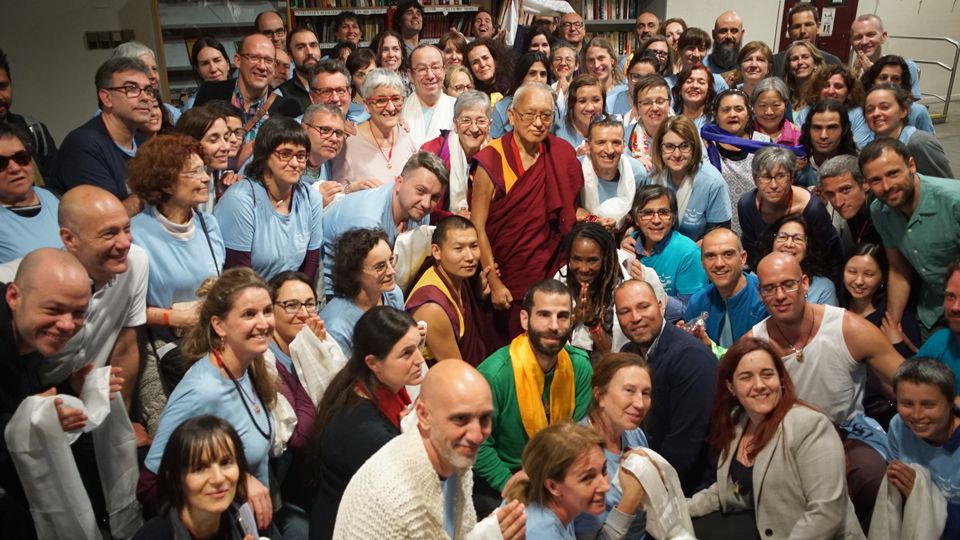
Lama Zopa Rinpoche with staff and volunteers for the teaching event in Madrid, Spain, April 29. Photo by Alexis Roitmann.
Lama Zopa Rinpoche taught in and traveled to a few FPMT centers in Spain in late April and early May. Kiko Llopis, FPMT Hispana national coordinator, shared this report on Rinpoche’s visit.
As he had promised in his previous visit to Spain in October 2018, Rinpoche returned to Madrid in April to confer the great initiation of the White Umbrella Deity (Dukkar). Rinpoche blessed us with his teachings, transmissions, and the longed-for initiation.
The event with Rinpoche was attended by more than 550 students. Nearly a hundred volunteers from the ten FPMT centers in Spain participated in organizing the event with enthusiasm and devotion. An added blessing during the teachings was the presence of Tenzin Ösel Hita—the recognized reincarnation of Lama Yeshe. Lama Yeshe co-founded the FPMT organization, together with Lama Zopa Rinpoche.
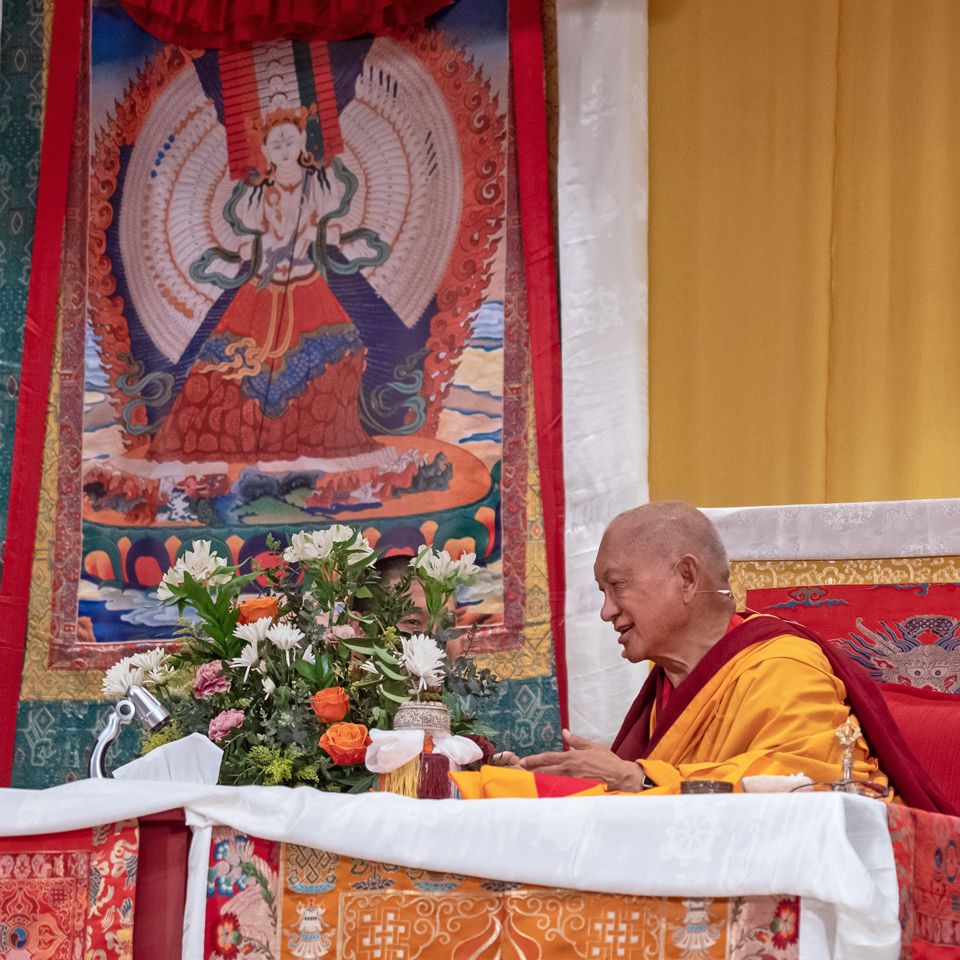
Lama Zopa Rinpoche during teachings in Madrid, Spain, April 2019. Photo by Harald Weichhart.
In addition to the benefit of his teachings, Rinpoche once again demonstrated his subtle but palpable quality of creating the conditions that manifest the best in the people around him—whether they are Buddhists or not, whether they know him or not. His love and compassion for all beings is a universal language that reaches everyone.
One example of this was the response of the staff at the General Union of Workers (UGT in Spanish) building, where the teaching event was held. UGT is one of the biggest unions in Spain. It has a Marxist origin and, by principle, is far from any religious affiliation. However, what began as a kind of curiosity for the colorful paraphernalia that accompanied the lectures of Rinpoche, who they saw as this “nice old man,” ended with a request from the UGT Head of the Administration for Rinpoche to bless her family. Plus, the maintenance staff ask about meditation, and the security staff gave us the facilities to hold a fire puja inside the building.
During his stay in Madrid, Rinpoche spent time in interviews with students and people with serious health problems. He also invited the ordained Sangha and members of the organization for dinner.
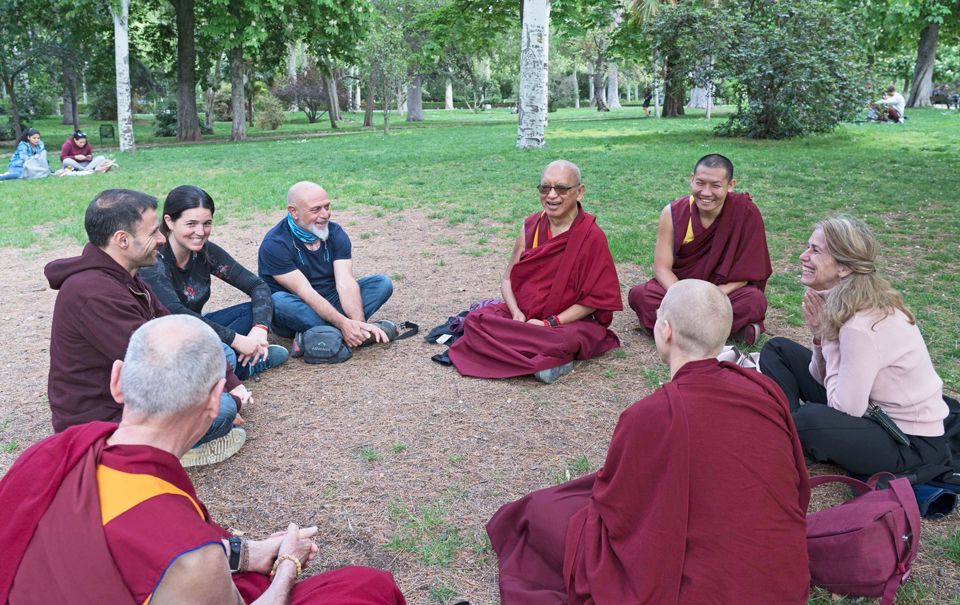
Rinpoche making prayers in the Retiro Park that any being that comes to the park will attain all the realizations up to enlightenment with (clockwise from bottom left) Ven. Roger Kunsang, Kiko Llopis, Miriam Woodnick, Juan Carlos, Ven. Topgye, Irina Hueso, and Ven. Holly Ansett.
There was also a wonderful afternoon stroll through the Retiro Park, which is one of the largest parks in Madrid, located near the city center. Rinpoche wanted to find a painter who sold paintings in the park. Rinpoche himself had given the painter several sacred images on his last visit, “not to sell them, but to exhibit them so people could benefit from seeing the images.” Rinpoche also blessed two large lakes in the Retiro, and all the aquatic inhabitants in the lakes, thus giving another example of how to make the most of a walk in the park.
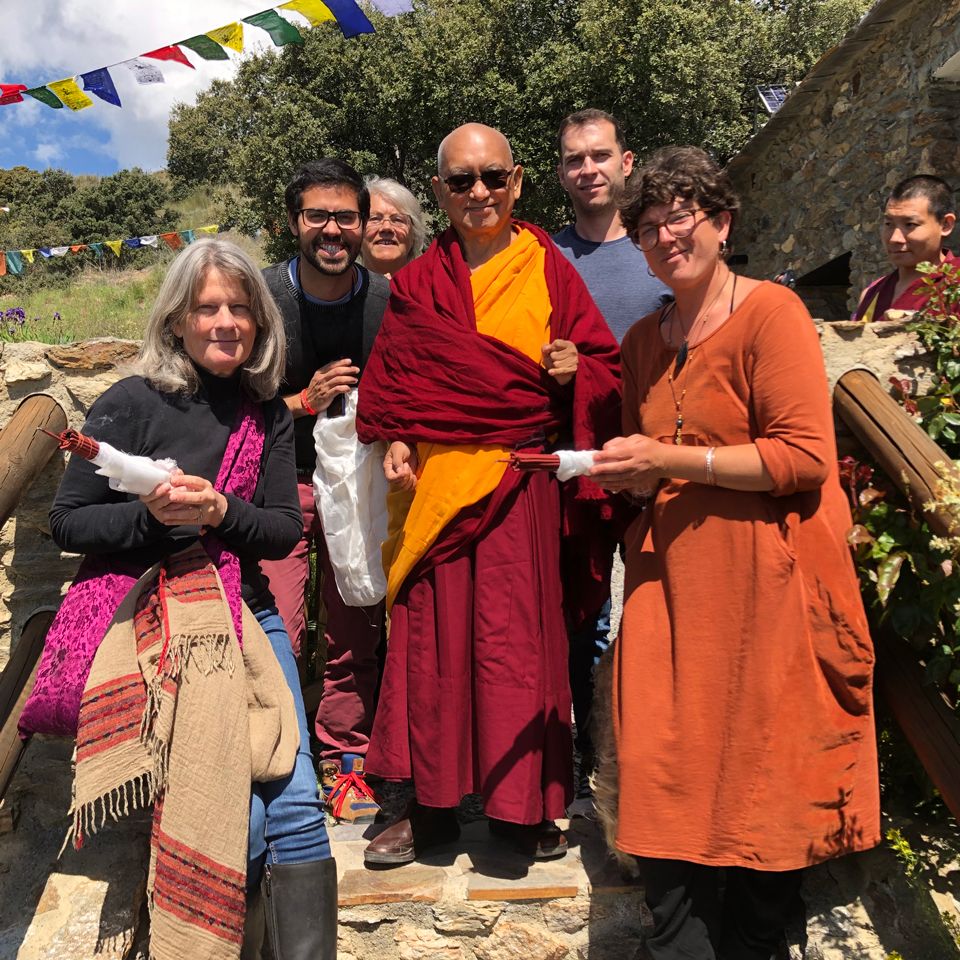
Lama Zopa Rinpoche being led to the new gompa at O.Sel.Ling Centro de Retiros by center director Anne Wenaas and students, Spain, May 2019. Photo by Ven. Roger Kunsang.
In addition to coming to Madrid, Rinpoche also visited three other FPMT centers in Spain. Rinpoche calls O.Sel.Ling Centro de Retiros, the FPMT retreat center located in the southern province of Granada, “Oseling pure land.” Rinpoche did extensive practices there and blessed the new gompa and sacred objects together with Geshe Lamsang, the FPMT resident teacher at Centro Nagarjuna Valencia. We are very excited because Rinpoche said it would be beneficial to return to O.Sel.Ling to give a retreat on the Thirty-Seven Practices of the Bodhisattva.
At the FPMT center Nagarjuna C.E.T. Granada, Rinpoche gave teachings and dined with some members of the center.
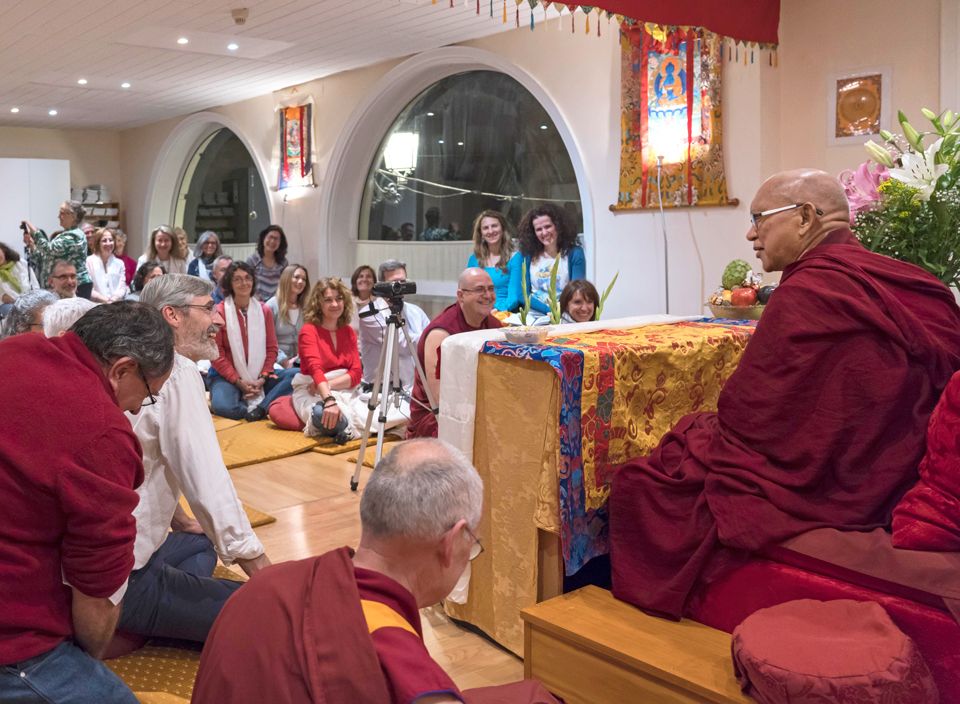
Lama Zopa Rinpoche teaching at Nagarjuna C.E.T. Granada in Granada, Spain, May 2019. Photo by Ven. Lobsang Sherab.

Lama Zopa Rinpoche with students from Centro La Sabiduría de Nagarjuna, the FPMT center in Bilbao, after having dinner with them, Bilbao, Spain, May 2019. Photo by Ven. Lobsang Sherab.
At Centro La Sabiduría de Nagarjuna, the FPMT center in Bilbao in northern Spain, Rinpoche gave an unscheduled commentary on the Dzambhala practice for the success of any project to be of the greatest benefit, especially the center’s hoped for new Lama Tsongkhapa retreat place, which he was dedicating to be of the greatest benefit.
Our precious guru left behind a ray of joy, gratitude, and enthusiasm in Spain, and we dedicate each day for him to visit us again very soon.
See more photographs from Lama Zopa Rinpoche’s visit to Spain:
https://fpmt.org/teachers/zopa/gallery/spain-april-may-2019/
Find complete videos of Lama Zopa Rinpoche’s recent teachings, including teachings from the April 2019 teachings in Madrid and the May-June 2019 Vajrayogini retreat at Institut Vajra Yogini in France:
https://fpmt.org/media/streaming/teachings-of-lama-zopa-rinpoche/
Lama Zopa Rinpoche is the spiritual director of the Foundation for the Preservation of Mahayana Tradition (FPMT), a Tibetan Buddhist organization dedicated to the transmission of the Mahayana Buddhist tradition and values worldwide through teaching, meditation and community service.
- Tagged: Centro La Sabiduría de Nagarjuna, fpmt hispana, lama zopa rinpoche, nagarjuna c.e.t. granada, nagarjuna c.e.t. madrid, o.sel.ling, spain
28
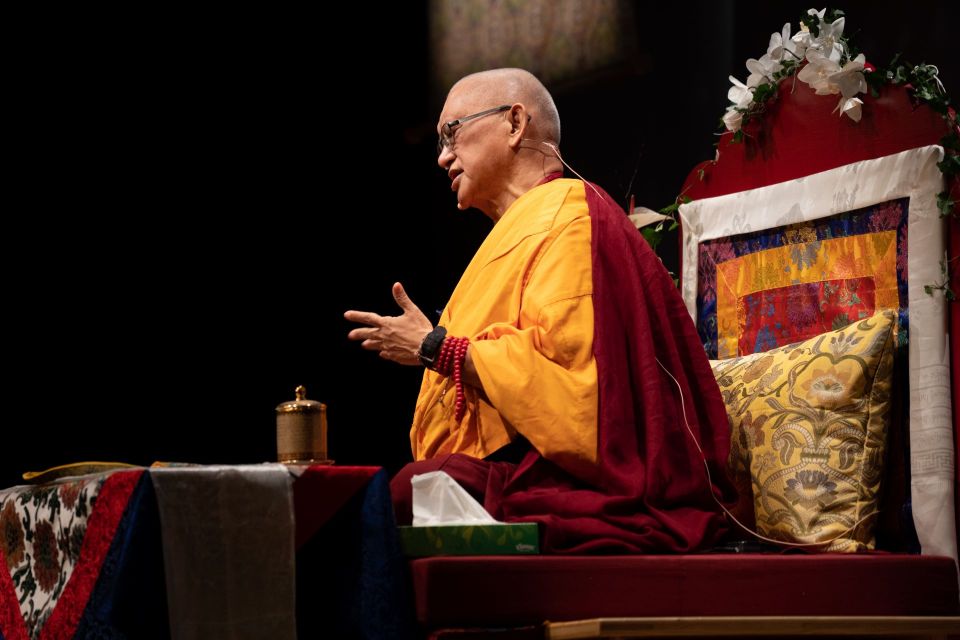
Lama Zopa Rinpoche teaching at an event organized by Gendun Drupa Center, Martigny, Switzerland, November 2018. Photo by Harald Weichhart.
During teachings in Switzerland in 2018, Lama Zopa Rinpoche taught on the importance of generating patience and creating happiness for others, captured in this excerpt and video clip:
Even if you don’t believe in reincarnation and karma, even those who are listening for the first time, if you practice patience, if there is no anger from your side, that brings so much happiness to you as you live life, and to your family, to society, to the country, and into the world.
You can bring so much happiness, peace, into the world. I heard that the First World War began with one person. It actually started with one person. If you have influence and power, it becomes like that. So it stops when it does not happen like that, when you practice patience. This is so important.
Even if the other person doesn’t practice patience, when you practice patience it brings so much happiness to the other person. You have to understand. It creates so much peace in the family. If you can do that, then you can bring peace into the world. In a big way, you can bring peace into the world.
As I mentioned the first First World War started with one person. So it’s like that, even if you don’t believe in reincarnation and karma. It’s so important to understand this.
Children in schools, primary schools, need this education in how to practice patience. How much peace there is in the future will depend on the present day children, what kind of education they get. Whether the future will be full of wars and killing each other or more peaceful depends especially on the present day children. When we are all dead, it depends on the present day children and their education.
If they have sangpo, holy education, if they have positive education, good education, that stops harm to others and harm to themselves—making their life black, nonvirtue, suffering, always confused, and causing others so much suffering, making suffering in the world, making so much suffering in the world. You make so much suffering for your family, your society, your country, your world. So much depends on good education, a good heart.
Even if you don’t believe in reincarnation and karma, you need compassion and loving kindness for others—for insects, even ants, not only for people. You can see that nobody wants suffering, even the ants. Nobody wants suffering; everybody wants happiness.
Therefore, if you think about your own happiness, if you have concern for yourself, then don’t harm others! In that case, you don’t harm! If you harm others, of course, that is the cause. And the result is that others harm you.
So if you get angry or you say some bad words to others, immediately you hear bad words from others directed at you. You create the target. You say bad words to others; you hear others say bad words to you. Immediately you get the arrow. So much of life is like that.
If you want happiness for yourself, don’t harm others. With body, speech, and mind, don’t harm others. If you want happiness, cause happiness for others, which will cause your happiness, benefit you, help you; others will cause happiness for you. From the karma, from the action, you can cause happiness for others. From that action, that karma, the result is you will get happiness from others. They will cause you happiness. So concerning your happiness, it’s like that. That is the correct way. We always have to keep the attention on that.
We need to get education of that in schools. We need to learn that. We always need to keep the awareness of that. But the best, of course, is to live life for others, free others from suffering. Live life to cause happiness for others—all the different levels of happiness up to enlightenment. …
Watch the teaching “The Best Way to Live Your Life,” from which this excerpt is taken:
https://youtu.be/m_titxURGec
Colophon: Excerpted from Lama Zopa Rinpoche’s teachings in Martigny, Switzerland, November 16, 2018. Simultaneously transcribed by Ven. Joan Nicell. Lightly edited by Laura Miller, June 2019.
Find complete videos of Lama Zopa Rinpoche’s recent teachings, including teachings from the May-June 2019 Vajrayogini retreat at Institut Vajra Yogini in France:
https://fpmt.org/media/streaming/teachings-of-lama-zopa-rinpoche/
Lama Zopa Rinpoche is the spiritual director of the Foundation for the Preservation of Mahayana Tradition (FPMT), a Tibetan Buddhist organization dedicated to the transmission of the Mahayana Buddhist tradition and values worldwide through teaching, meditation and community service.
- Tagged: essential extract, patience, peace, video, war
24
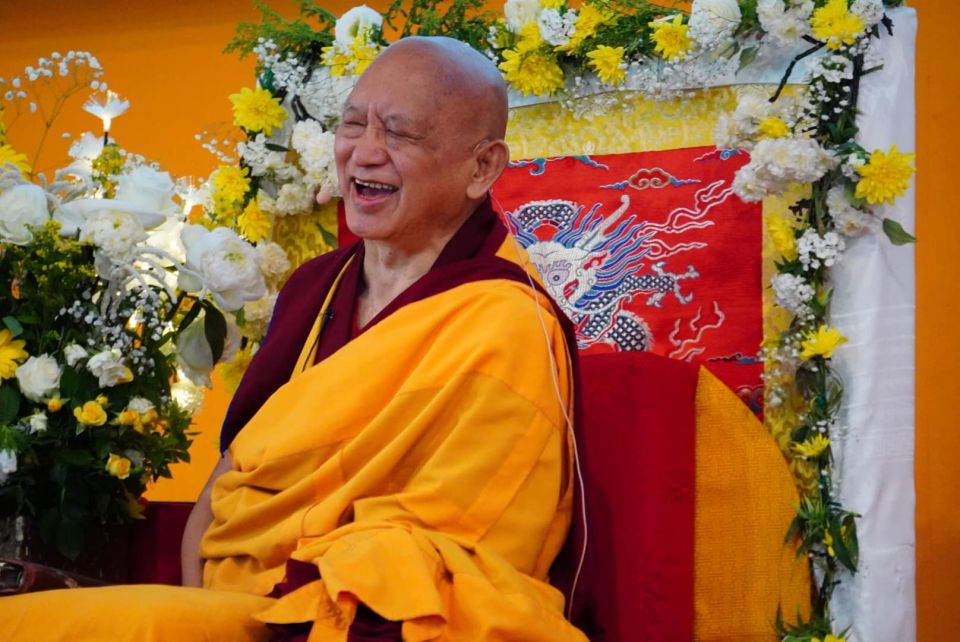
Lama Zopa Rinpoche during long life puja at Institut Vajra Yogini, France, 2019. Photo by Ven. Tenzin Tsultrim.
At the conclusion of the Vajrayogini retreat at Institut Vajra Yogini in France, Lama Zopa Rinpoche was offered a long life puja, where long-time American student Merry Colony recited the following praise for Lama Zopa Rinpoche:
In this time of over degeneration,
When our kind mothers are blindly rushing about their lives,
Wanting only happiness while creating causes only to suffer,
Due to the inconceivable kindness of the Guru,
We have found ourselves here,
In the pure realm of Vajra Yogini,
And for thirty-five glorious days we have experienced the fully ripened result of our impossible-to-find and truly miraculous perfect human rebirths.
Having been called to create virtue each day by the sound of the blessed gong, which merely by hearing purifies the five uninterrupted negative karmas,
We have passed each day beneath the sweet smelling honeysuckle flowers accompanied by the soft cooing of doves,
And have joyously gathered, hundreds of your children disciples, like swans coming to a lake,
To drink the nectar of the Guru’s holy speech.
When the Guru’s holy body enters the vajra tent, before even a word is spoken, we are given our first teaching:
Make the efforts of our parents worthwhile and use this body to create merit.
For how can we give in to laziness when we are witness to you, our refuge savior,
Manifesting paralysis yet still prostrating with such supreme effort before the throne each day?
Such a kindness can be found nowhere else in this world.
Once seated upon the vajra throne your display of skillful means is without compare:
The wrathful roar that clears away the thick fog of our ignorance,
The circuitous stories that sharpen our attention,
The vajra laughter that awakens our blissful awareness.
Where else in all the three realms can one find such a teacher?
In a single moment you show the simultaneous aspects of,
Gentle virtue beggar and powerful Mahayana Vajrayana guru,
Precious one who subdues, wrathful one who conquers.
To such greatness all humans and gods bow their heads.
Your melodic chanting and explanation of the four line Vajra Cutter
Implores us to see that like a drop of dew this life will soon be gone,
To examine the profound meaning of rabrib, the defective view that keeps us imprisoned,
To loosen our grip on what we mistakenly believe to be real by seeing everything as illusion.
Withholding nothing, you illuminate the heart of the path: the profound meaning of the Guru, one taste with great bliss dharmakaya.
Using your own life story as an example, you clarify the true meaning of Dharma practice: giving up this life!
Quoting from Kyabje Khunu Lama Rinpoche, you strengthen our refuge in bodhichitta, the unbetraying friend in samsara.
With diamond-like precision, you elucidate the very huge difference between correctly meditating on emptiness and incorrectly meditating on nihilism.
While we may not have yet realized renunciation, bodhichitta, or emptiness,
There is one thing we do know without mistake or doubt:
When the kind and holy lord Guru is teaching,
There is nowhere else we ever, ever want to be.
Until enlightenment, may we always be among your foremost disciples fulfilling your every wish.

Offering being made to Lama Zopa Rinpoche during long life puja, Institut Vajra Yogini, France, 2019. Photo by Ven. Tenzin Tsultrim.
Now, together here, due to the Guru’s unfathomable kindness,
We have taken the Most Secret Hayagriva for long life, Heruka Five Deity, and Vajrayogini initiations,
We have engaged in the heart practice of Lama Chopa daily,
And have begun practicing the yogas of sleep, waking, and tasting nectar.
We have strengthened our familiarization with taking ordinary death, intermediate state, and rebirth into the path to achieve the three kayas,
And collectively we have accumulated more than ten million mantras of the Kechara Yogini.
May all of this merit, together with the three time merits of all sentient beings and buddhas, who do not exist, who are empty,
Be the cause for the most holy kind Guru Buddha Deity to have an infinitely long and stable life.
May you quickly return to this best of FPMT centers and
Continue to teach the Vajrayogini commentary as well as the three-year retreat instructions.
From our side we will practice as taught and dedicate every merit created to the fruition of full enlightenment so that we can most quickly, fully benefit all beings.
By the power of the Three Rare Sublime Ones,
By the power of the buddhas’ and bodhisattvas’ blessings,
By the power of this pure prayer,
And the auspicious convergence of our karma and the Guru’s unbearably great compassion,
Precious Refuge Savior heed our prayer:
Please, please live long.
Please, please live very long.
Please, please live infinitely long.
Colophon: Written and read by your devoted disciple Merry Colony, Yeshe Dechen, at the conclusion of the Vajrayogini retreat at Institut Vajra Yogini, France, June 13, 2019.
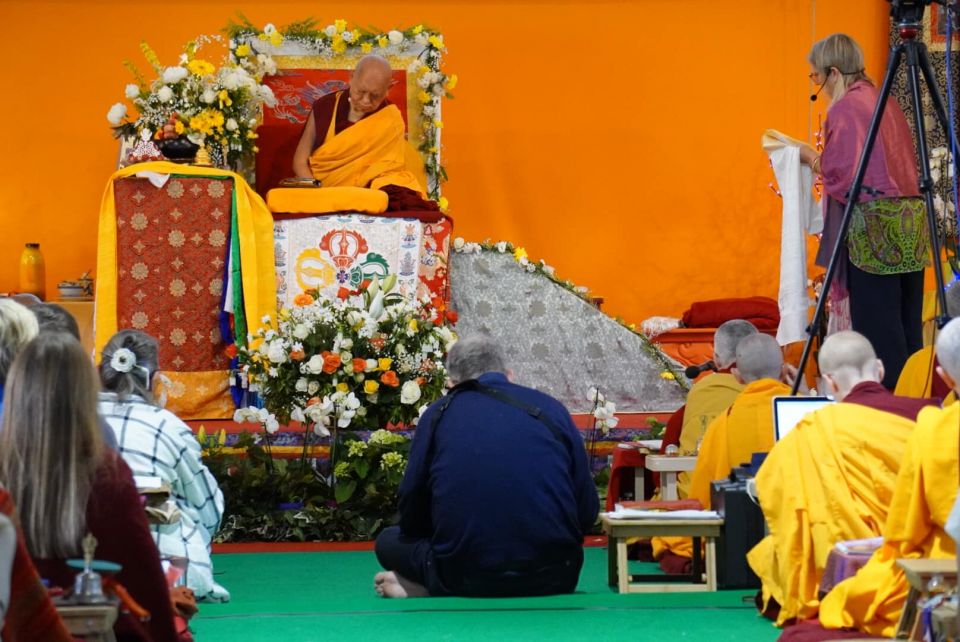
Merry Colony reading praise for Lama Zopa Rinpoche during long life puja at Institut Vajra Yogini, France, 2019. Photo by Ven. Tenzin Tsultrim.
Find complete videos of Lama Zopa Rinpoche’s recent teachings, including teachings from the May-June 2019 Vajrayogini retreat at Institut Vajra Yogini in France:
https://fpmt.org/media/streaming/teachings-of-lama-zopa-rinpoche/
Lama Zopa Rinpoche is the spiritual director of the Foundation for the Preservation of Mahayana Tradition (FPMT), a Tibetan Buddhist organization dedicated to the transmission of the Mahayana Buddhist tradition and values worldwide through teaching, meditation and community service.
- Tagged: lama zopa rinpoche, lama zopa rinpoche long life puja, long life puja, merry colony, praise for lama zopa rinpoche
17
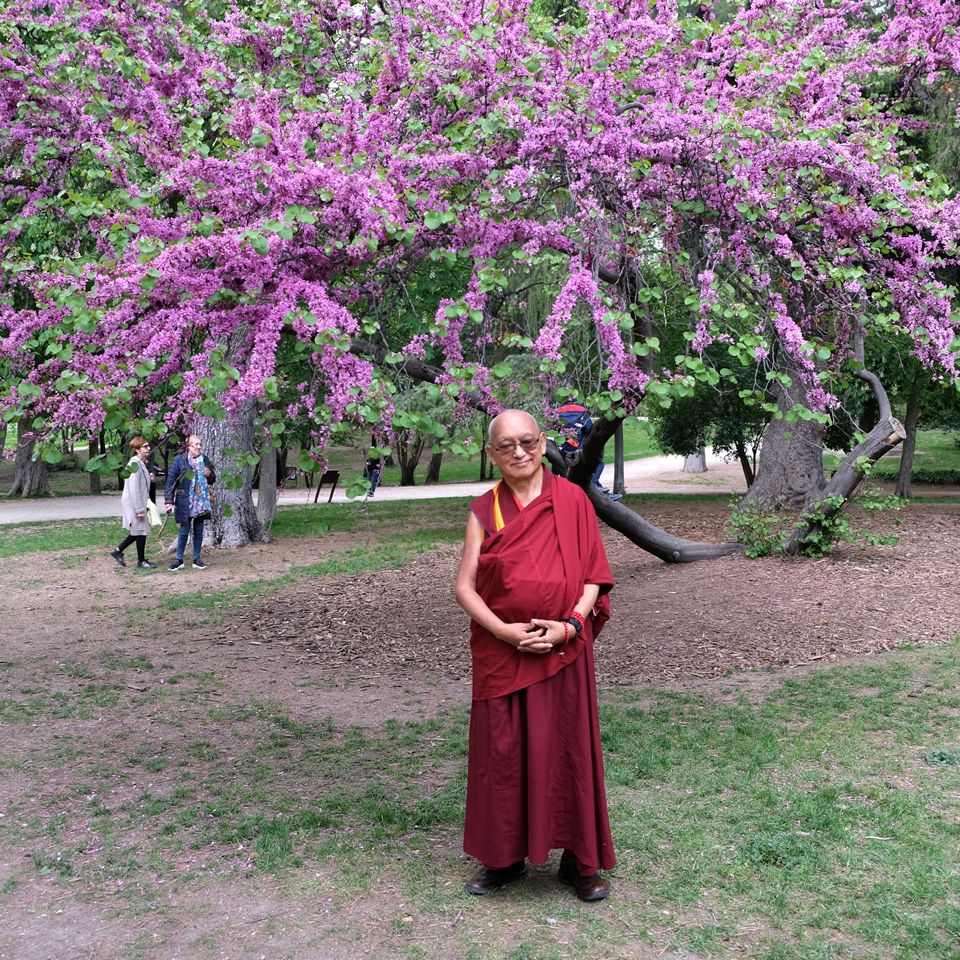
Lama Zopa Rinpoche enjoying a park in Madrid, Spain, April 2019. Photo by Ven. Roger Kunsang.
Lama Zopa Rinpoche taught on how everything we receive, even the motivation of bodhichitta, comes through the kindness of other sentient beings during teachings given at Amitabha Buddhist Centre in Singapore in September 2018. Lama Zopa Rinpoche explained why and how all happiness comes from good karma and how good karma comes from the buddhas. He continued by explaining how we can stop rebirth in the lower realms and how the insight on the kindness of all sentient beings makes us want to repay their kindness. Here’s an excerpt from the teaching:
What makes life most beneficial to numberless sentient beings, the happiest life, is bodhichitta, living life with bodhichitta—the happiest life, no regret now and no regret in the future. It’s the happiest life, if you want to know.
With bodhichitta when you get sick, you are sick for sentient beings. You are so happy, unbelievably happy, even [if you have] cancer. Having sickness for sentient beings—with bodhichitta you are dying, dying for sentient beings—you are so happy. Anything, whatever happens to you, incurable disease, whatever, you are so happy; you experience it for sentient beings. It is the best, best life. So like that.
Whatever you are doing, you do for numberless sentient beings, including not only those who are helping you, even for those who don’t do harm or don’t help, even a stranger. When you generate bodhichitta, it is for everyone. There is no partisanship—you do if for some sentient beings, but some sentient beings you hate and you don’t do it for them. No, you do for everyone, so it is fantastic.
If you live life with bodhichitta, then you see that whatever happens to your life, it is for sentient beings—even if you have cancer, it is for sentient beings; even if you have health, it is for sentient beings; even if you have short life, it is for sentient beings; even if you have a long life it is for sentient beings—everything. [Living life with bodhichitta creates a] most happy, most happy life. Even if you have constant problems in this life, a difficult life, it is for sentient beings. There is nothing for you; it is all for sentient beings, numberless sentient beings, including your friends, strangers, enemies, everyone. It is really wonderful—wow, wow, wow, most wonderful life.
So, you see, there is incredible happiness. Your mind is always full of happiness, nothing involved with self-cherishing thoughts—only me, me, me. No, there is no problem with that, even though from beginningless rebirths, it has been like this—me, me, me, day and night, me, me, me, When I can be happy?, When I can be happy?, When I can be free from problems?—with the self-cherishing thought trying to achieve happiness for yourself. From beginningless rebirths, today is not the first time. We have been doing this from beginningless rebirths, still not complete, still not, so like that. …
Watch the teaching from which this excerpt is taken:
https://youtu.be/WRgkM2NVtUo
Colophon: Excerpted from Lama Zopa Rinpoche’s teachings in Singapore, September 19, 2018. Simultaneously transcribed by Ven. Joan Nicell. Lightly edited by Laura Miller, June 2019.
Find more video of Rinpoche teaching at Amitabha Buddhist Centre in Singapore:
https://fpmt.org/media/streaming/teachings-of-lama-zopa-rinpoche/amitabha-buddhist-center-2018/
Watch recorded video of Rinpoche’s recent teachings from the Vajrayogini retreat at Institut Vajra Yogini in France:
https://fpmt.org/media/streaming/teachings-of-lama-zopa-rinpoche/vajrayogini-retreat-2019/
Lama Zopa Rinpoche is the spiritual director of the Foundation for the Preservation of Mahayana Tradition(FPMT), a Tibetan Buddhist organization dedicated to the transmission of the Mahayana Buddhist tradition and values worldwide through teaching, meditation and community service.
14
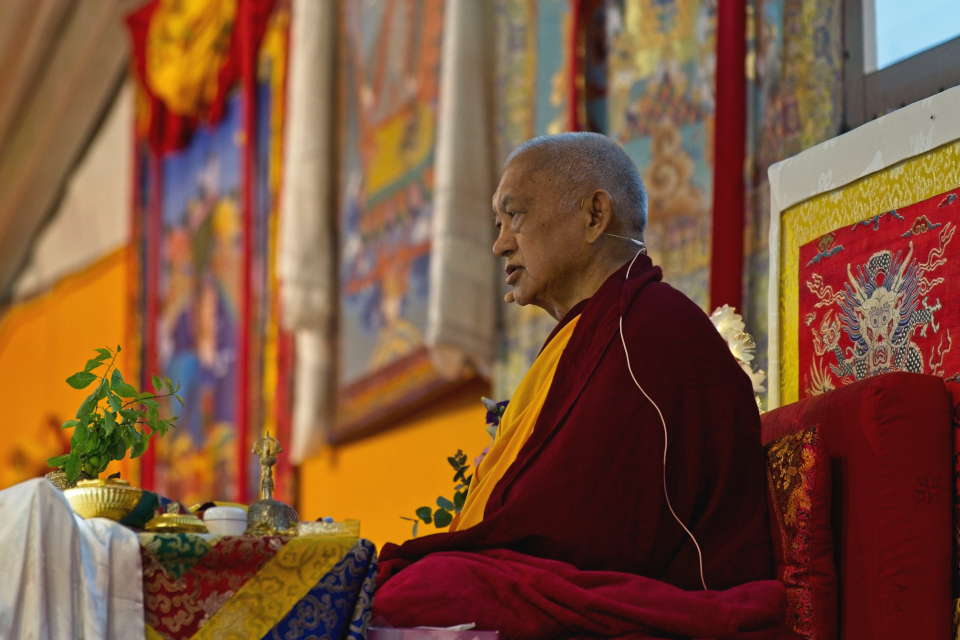
Lama Zopa Rinpoche teaching at Vajrayogini retreat, Institut Vajra Yogini, May 2019. Photo by Tsanka Petkova.
The five-week Vajrayogini retreat with Lama Zopa Rinpoche, hosted by Institut Vajra Vogini in the south of France, draws to a close on Saturday, June 15. FPMT students from around the world are attending the retreat. (Read a report from the first two weeks here.) Gordon McDougall, a long-time student of Rinpoche and frequent editor of Rinpoche’s books, is at Institut Vajra Yogini and shares this report:
Now we are into the final week of the five-week Vajrayogini retreat, it’s hard to know what to say about such a powerful event. Certainly the joy when it was announced that Lama Zopa would stay until the end of the retreat and give an Amitayus initiation was universal, but retreats are very personal affairs, meaning different things to each retreatant. There does seem to have been a fair mixture of ecstasy and agony, lots of colds, and even a few hospitalizations, but the overall atmosphere has been one of great joy and harmony.
So, how to sum it up? Perhaps it can be concentrated into four words:
amazing, amazing, amazing, amazing
Amazing is the place itself. Forty years of love and blessings have turned Institut Vajra Yogini into a wonderful space. The glorious chateau, the awe-inspiring stupa, the lovely walks through the wood to the ridge overlooking the quintessential French countryside—the superlatives can go on.
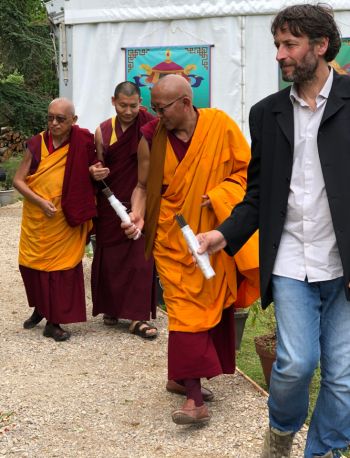
Lama Zopa Rinpoche being led by Institut Vajra Yogini director François Lecointre and Geshe Loden, resident geshe, Institut Vajra Yogini, France, May 2019. Photo by Ven. Roger Kunsang.
Amazing too is the event provided by the staff of Vajra Yogini. Over forty volunteers made our job of meditating so much easier (but still not easy). It’s impossible to exaggerate the loving care they have taken with every tiny detail of the retreat. At every turn there is a reminder of how they have anticipated a retreatant’s needs and wishes, from qi gong sessions to tablet recharging areas to a nurse’s station to continuous free tea and coffee to the shuttle service for people living outside—even an exercise bike! And Rinpoche agrees, saying that Institut Vajra Yogini is the “best example of service in FPMT,” so good “even the birds are talking about it!”
The retreat itself has been amazing. Not just because Rinpoche has taught almost every night and not just for delicious French pastry that was our usual midnight tsog, but the session-by-session business of doing a retreat. The leader, Ven. Chantal Carrerot, was superb. Taking time off from creating the nearby Monastère Dorje Pamo, she was the perfect mixture of gentle and firm. Few were able to resist her quiet suggestions we all remain in silence, said so sweetly and so insistently. The technology of enlightenment also just gets better and better, with new downloads of prayers and images, if not daily, then quite often. And again, it’s little things like seeing the livestream of Rinpoche arriving and leaving projected on to the large screen in the teaching tent, rather than just hearing him giggle but invisible beyond a forest to retreatants. And of course, Rinpoche. He seems to be getting more entertaining each year (the “Solu Khumbo comedian” he calls himself), able to flip us from tears of compassion over the suffering of conveyor belt pigs to tears of laughter at some wonderfully observed absurdity of samsara. His message hasn’t changed, and it is one we all need so much.
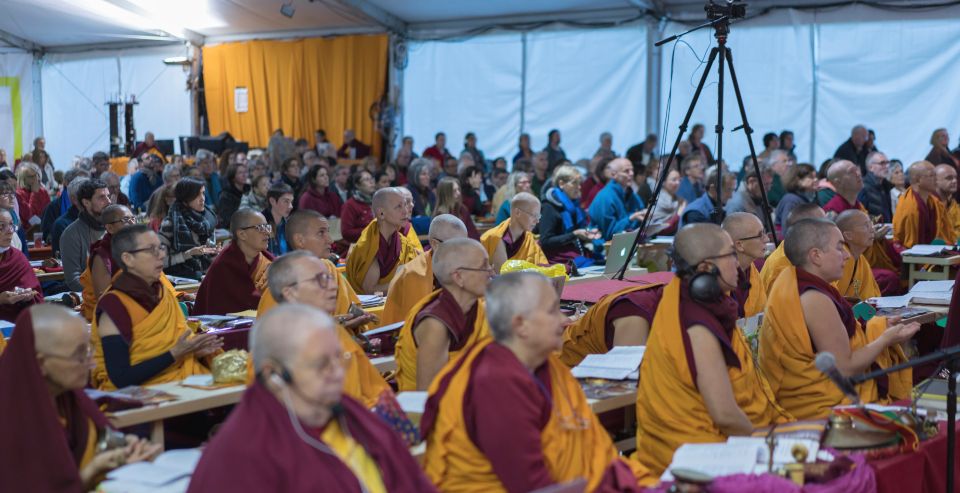
Retreatants during Lama Zopa Rinpoche’s teaching, Institut Vajra Yogini, France, May 2019. Photo by Ven. Lobsang Sherab.
Amazing indeed were the fellow vajra brothers and sisters who shared the retreat—from the old guard who were there at the very beginning of FPMT, such as Ven. Karin Valham (who has transformed the lives of tens of thousands of people in her more than three decades of teaching at Kopan Monastery in Nepal), to many newer students. And they come from all over the world, a greater diversity of countries than I’ve seen at any Rinpoche event. There was a big contingency from Australasia and North America as well as the usual Europeans, but also many Chinese from South East Asia, Taiwan, and Mainland China, and places such as Mexico, Mongolia, Russia, Latvia, and … the list goes on. Such a diverse group of people on one hand and so united in our love and devotion to Rinpoche on the other. It is truly inspiring to chat over a tea and discover the countless ways we are all working for Rinpoche and, because of that, for all beings.
Rinpoche told us at the beginning to not worry about counting mantras for the retreat because he wanted to give us a commentary on Vajrayogini. So far, he has not gone beyond the preliminaries, concentrating on lamrim, lamrim, and lamrim. However, there are those among us who feel he must finish the commentary and therefore must return to Institut Vajra Yogini to continue it next year, and the year after, and the year after. … And we’ll be there for another amazing, amazing, amazing, amazing retreat.
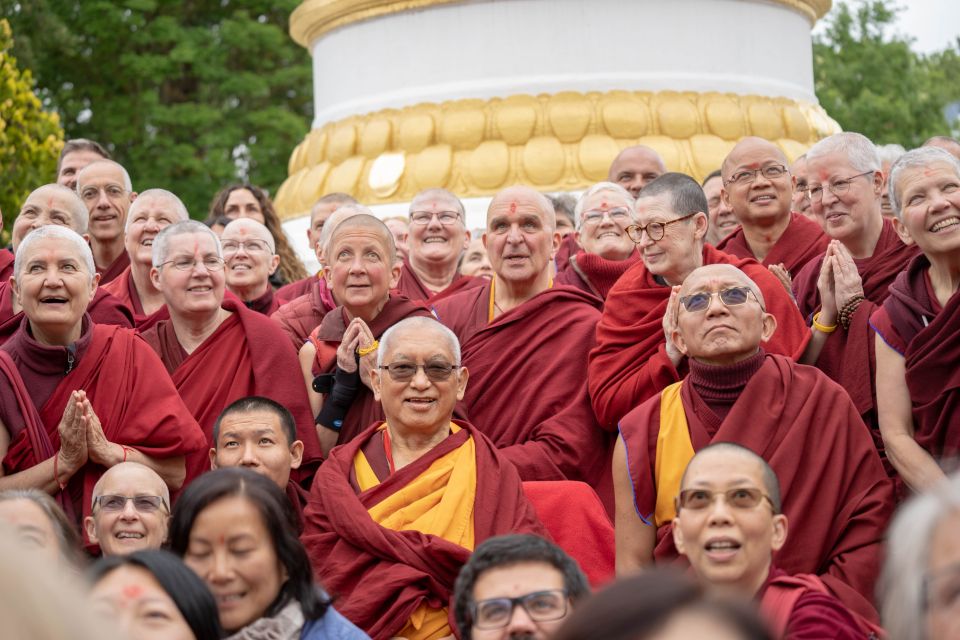
Lama Zopa Rinpoche with ordained Sangha and lay students attending the Vajrayogini retreat at Institut Vajra Yogini, France, May 2019. Photo by Tsanka Petkova.
Watch recorded video of Rinpoche’s teachings from the Vajrayogini retreat here:
https://fpmt.org/media/streaming/teachings-of-lama-zopa-rinpoche/vajrayogini-retreat-2019/
FPMT Education Services has created a lamrim resource page where students may find advice and materials to support their practice:
https://fpmt.org/education/prayers-and-practice-materials/lam-rim/
Lama Zopa Rinpoche is the spiritual director of the Foundation for the Preservation of Mahayana Tradition(FPMT), a Tibetan Buddhist organization dedicated to the transmission of the Mahayana Buddhist tradition and values worldwide through teaching, meditation and community service.
27
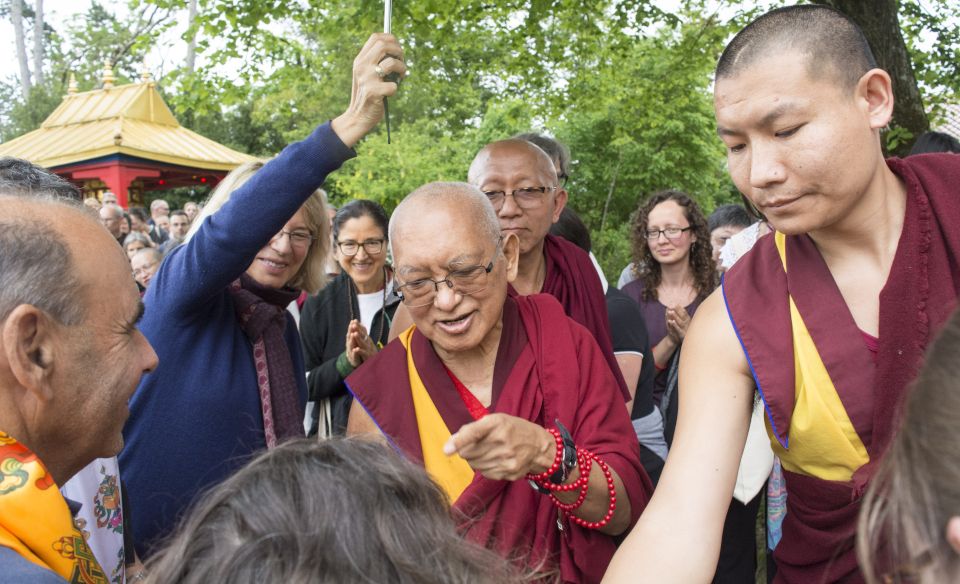
Lama Zopa Rinpoche at the beginning of the Vajrayogini Retreat at Institut Vajra Yogini, Marzens, France, May 2019. Photo by Tsanka Petkova.
Lama Zopa Rinpoche is currently in the middle of teaching at the five-week Vajrayogini Retreat at Institut Vajra Vogini in the south of France. FPMT students from around the world—many of them students of Rinpoche for more than thirty years—are attending the retreat, which began on May 10. More than 450 people attended the first two weeks of the retreat, including about fifty ordained Sangha. More than 250 students are staying for the entire retreat.
Gordon McDougall, a UK student of Rinpoche and frequent editor of Rinpoche’s books, is attending the retreat and shares this report:
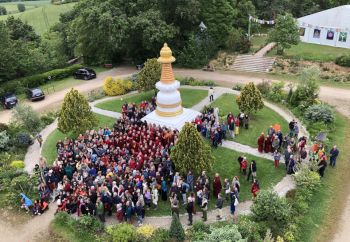
Varjayogini Retreat participants in front of the Kadampa stupa at Insitut Vajra Yogini, France, May 2019
Greetings from Vajrayogini’s pure land, as Lama Zopa Rinpoche so aptly named Institut Vajra Yogini (IVY) at the beginning of the five-week Vajrayogini retreat. I remember when Violette (one of the retreat’s key organizers) first told me Rinpoche had accepted to lead this retreat, it seemed that it would be something very special, and it is proving to be that.
What could have been an organizational nightmare has been made to look blissfully easy by the IVY team, which includes seventy volunteers. The chateau and grounds (and the beautiful French countryside around) are at their best, and the huge teaching tent feels surprisingly spacious. There is the usual array of audio-video equipment for the interpreters, video recording, and live webcast, and a big screen for Ven. Joan Nicell’s simultaneous transcriptions of Rinpoche’s teachings. And there are many flowers, offerings, and thangkas. If you’ve been to a big Rinpoche teaching event, you’ll probably be able to picture it well.
What I notice here, though, is the meticulous eye for detail, from the seating arrangements to the surprising small tables we each have. (When Ven. Chantal Carrerot, the retreat leader, mentioned that the table tops lift and the legs extend, she had to break for a few minutes while we all had great fun playing with them.)
It was wonderful to see the care the team took with the students as they arrived. Because there had been a general strike in France right before the retreat began, people had been stuck in strange cities or forced to find other ways of getting here and many arrived without their baggage, which was floating around France somewhere. In short, chaos, but it hasn’t seemed like that from this side. The team worked so hard to ensure everybody settled in without hassle.
As usual, the first couple of days were a frenzy of reunions. The energy was so high, with people who have been Dharma siblings for decades meeting each other again. I found it quite daunting to face so many people at once and so much hugging and greeting, but, at the same time, it is a fantastic feeling to be back among the FPMT family. And it really does feel like a family. I have known some—many—of the people smiling at me as we go around the big Kadampa stupa for thirty years. They are still at it, still devoted to our amazing holy guru. We worked out there is probably over 10,000 years Dharma experience here. All we have to do now is get enlightened.
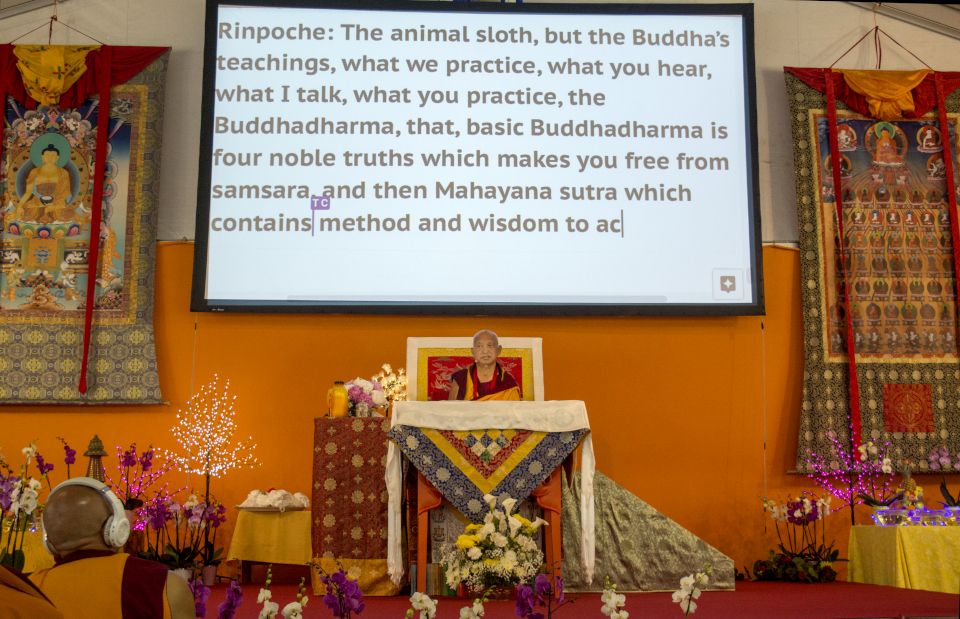
Lama Zopa Rinpoche teaching during the Vajrayogini Retreat, Institut Vajra Yogini, France, May 2019. Photo by Tsanka Petkova.
Owen Cole, a long-time FPMT student from Hayagriya Buddhist Centre in Perth, Australia, shares his experience of the first part of the retreat:
The retreat has every thing going for it. During the Heruka and Vajrayogini initiations, Lama Zopa Rinpoche pushed students to the limit with two separate nights of only three hours sleep, though we did get a generous break the next day. The students have responded with enthusiasm and discipline by attending sessions and observing course discipline, such as the silence periods.
The program follows the one favored by Rinpoche in retreats around the world with Guru Puja/Jorcho and additional prayers chanted first thing. This is followed by the sadhana or a teaching by Rinpoche or a talk by a Western Sangha member. We do protector prayers at night. Though everything is subject to change and often does.
IVY director Françios Lecointre and his amazing team are an inspiration for how they have organized the retreat, which has stretched the center’s facilities to capacity. Ever room in the old chateau is jam packed full of people with the overflow housed at nearby Nalanda Monastery, Dorje Palmo Nunnery, and other facilities near the quintessentially French town of Lavaur.
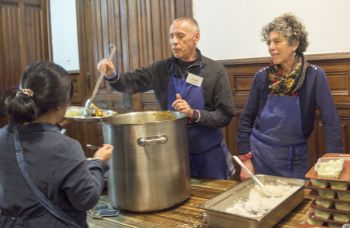
Volunteers serving a meal at the Varjayogini Retreat, Institut Vajra Yogini, France, May 2019. Photo by Tsanka Petkova.
The IVY staff and volunteers have gone out of their way to make the minds of participants happy, offering sun lounges to relieve the pressure on campers, umbrellas when it started raining, and extra blankets for those feeling the cold; taking great care of those who had to be hospitalized; and providing beautiful food in copious quantities. The volunteers are working to the point of exhaustion to help retreatants and keep things running smoothly. And they are patiently doing everything with a smile, which creates a wonderful sense of cooperative community.
Lama Zopa Rinpoche acknowledged their efforts in a teaching by saying their work had already achieved the same result of many lifetimes of retreat, adding that they had purified so many eons of negative karma as they were helping people look after their minds.
You can find links to live webcast of Rinpoche’s teachings here:
https://fpmt.org/media/streaming/lama-zopa-rinpoche-live/
Watch recorded video of the non-restricted teachings from the retreat here:
https://fpmt.org/media/streaming/teachings-of-lama-zopa-rinpoche/vajrayogini-retreat-2019/
Lama Zopa Rinpoche is the spiritual director of the Foundation for the Preservation of Mahayana Tradition(FPMT), a Tibetan Buddhist organization dedicated to the transmission of the Mahayana Buddhist tradition and values worldwide through teaching, meditation and community service.
11
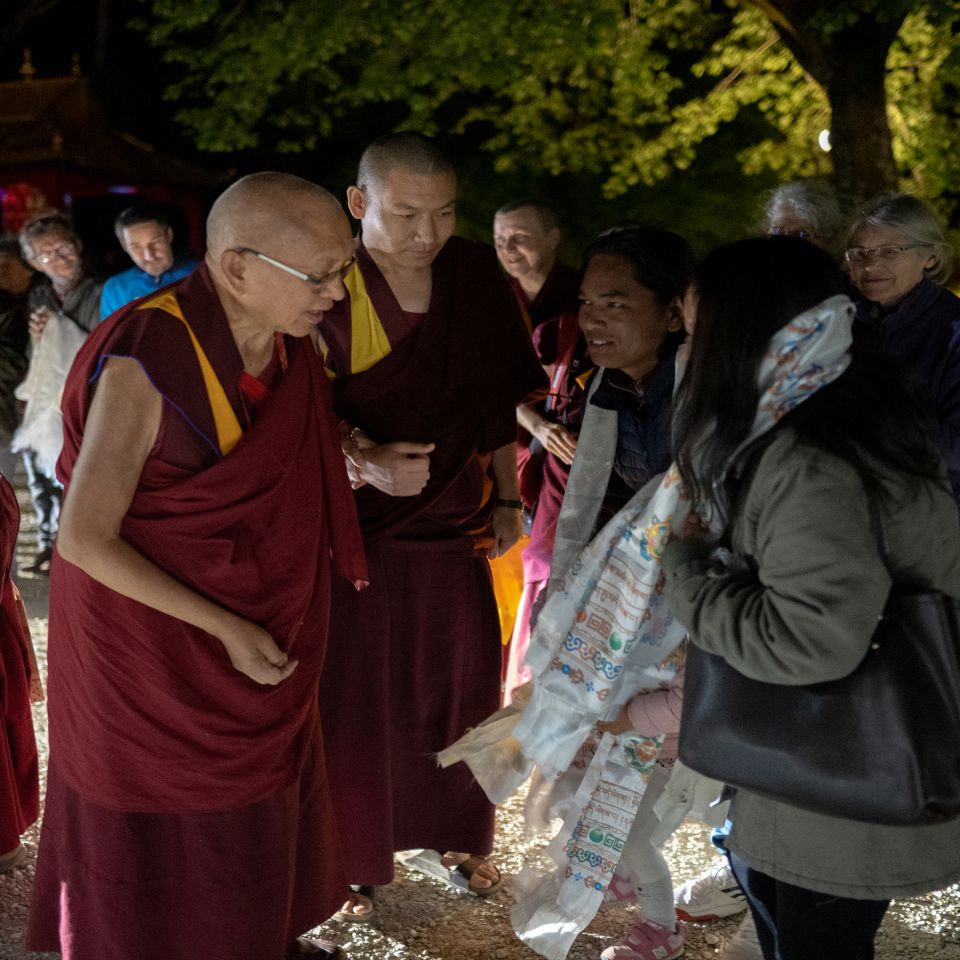
Lama Zopa Rinpoche arriving at Institut Vajra Yogini, Marzens, France, May 2019. Photo by Harald Weichhart.
Lama Zopa Rinpoche recently arrived at Institut Vajra Yogini (IVY) after giving teachings in Spain. A large gathering of students held khatas, glowing LED lights, and banners depicting the eight auspicious symbols as they awaited his night-time arrival at the FPMT center in southern France.
On Saturday, May 11, Rinpoche began teaching at a five-week Vajrayogini retreat, hosted by IVY. More than 400 students from around the world are attending the first ten days of the retreat. More than 250 students will be attending the entire retreat. Preliminary and non-restricted teachings by Rinpoche at the retreat will be webcast live.
For details and links to watch Rinpoche teach live:
https://fpmt.org/media/streaming/lama-zopa-rinpoche-live/
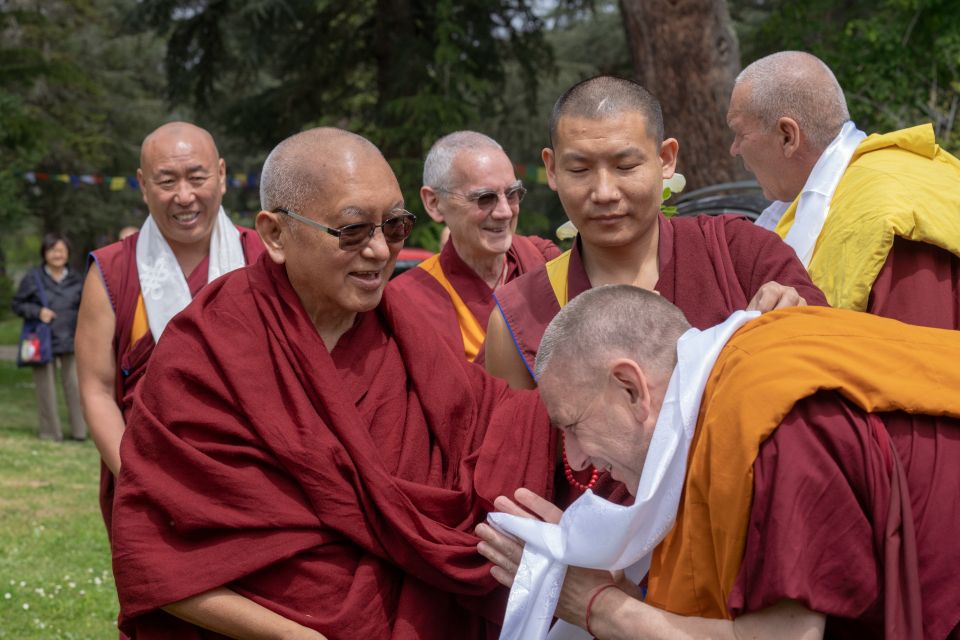
Lama Zopa Rinpoche at Nalanda Monastery, Labastide Saint Georges, France, May 2019. Photo by Harald Weichhart.
On May 9, Rinpoche visited nearby Nalanda Monastery, where Rinpoche was offered lunch and was greeted by the resident monks and other students. Rinpoche gave an oral transmission and teaching during his visit there.
Watch the video of Rinpoche’s arrival at IVY:
https://youtu.be/dA6ioxd2vm4
Watch Lama Zopa Rinpoche’s recent teachings from Madrid, Spain, on FPMT.org:
https://fpmt.org/media/streaming/teachings-of-lama-zopa-rinpoche/madrid_2019/
Lama Zopa Rinpoche is the spiritual director of the Foundation for the Preservation of Mahayana Tradition(FPMT), a Tibetan Buddhist organization dedicated to the transmission of the Mahayana Buddhist tradition and values worldwide through teaching, meditation and community service.
6

Lama Zopa Rinpoche being led to the gompa at O.Sel.Ling Centro de Retiros by center director Anne Wenaas and Ven. Topgye, Spain, May 2019. Photo by Ven. Lobsang Sherab.
Lama Zopa Rinpoche wrote a benefactor thanking them for their support of a center and explaining a center’s benefits.
I just want to send you these cards and tell you that I highly appreciate your kindness in helping the center. The purpose of the center existing continually is to help sentient beings, and what sentient beings need most is to be free from the oceans of suffering, which is what they have been experiencing from beginningless rebirths. That means to be free from the oceans of samsaric suffering—the sufferings of rebirth, old age, sickness and death, and so forth. This is the suffering of pain. Then there is the suffering of change—all the samsaric pleasures, which cannot continue.
When we achieve enlightenment, that is when Dharma happiness is completed. The nature of samsaric pleasure is suffering. The suffering of pain and the suffering of change come from the third suffering, which is pervasive compounding suffering.
To be free from these three sufferings forever, we need to cease the cause of suffering—delusion and karma. For this we can’t have an operation in the hospital, or have it taken it out by a doctor or take tablets so it goes away. We can’t do that, it’s impossible. The only method is Dharma, the Buddha’s teachings. The centers are for that. That’s why the center is teaching Dharma, providing qualified teachers, translators, a place to practice, to hear the teachings and so many things.
This is a most urgent thing for sentient beings, more urgent than anything else. Not only that, through this it brings sentient beings to buddhahood, the total cessation of all the obscurations and completion of all realizations. Therefore, the need for the center to exist and to continue is of utmost importance for sentient beings.
By helping the center, you are helping all sentient beings, because then people come to learn Dharma at the center, and to practice bodhichitta, as they do the practice for all sentient beings, to benefit all sentient beings. That is how the center benefits numberless hell beings, numberless hungry ghosts, numberless animals, numberless human beings, numberless sura beings, numberless asura beings and numberless intermediate state beings.
From Lama Zopa Rinpoche’s advice “The Center is of Utmost Importance,” posted on the Lama Yeshe Wisdom Archive in December 2018:
https://www.lamayeshe.com/advice/center-utmost-importance
Watch Lama Zopa Rinpoche’s recent teachings in Madrid, Spain:
https://fpmt.org/media/streaming/teachings-of-lama-zopa-rinpoche/madrid_2019/
Lama Zopa Rinpoche is the spiritual director of the Foundation for the Preservation of Mahayana Tradition (FPMT), a Tibetan Buddhist organization dedicated to the transmission of the Mahayana Buddhist tradition and values worldwide through teaching, meditation and community service.
- Tagged: centers, lama zopa rinpoche
3
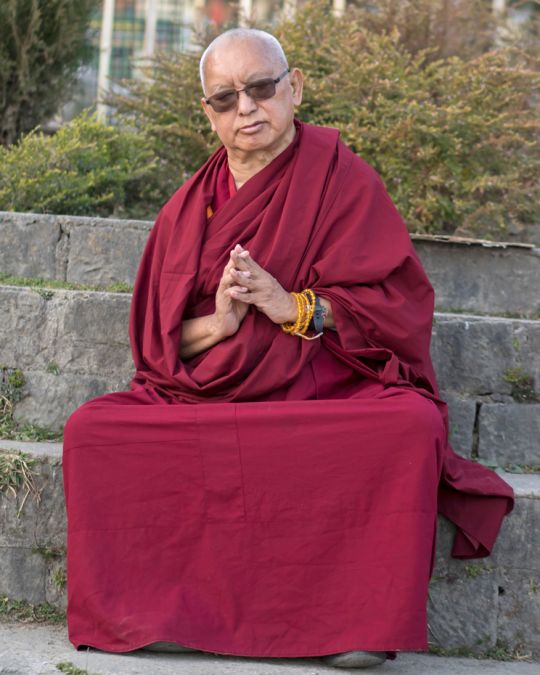
Lama Zopa Rinpoche making prayers at Tso Pema, India, January 2018. Photo by Ven. Lobsang Sherab.
Lama Zopa Rinpoche advised a student who wanted to help the sick and dying.
You don’t have to go [to the hospital] to help them; instead, wherever you stay, you can do the Eight Prayers to Benefit the Dead. Recite a different one, or two, each day, dedicated for them, for example, the “King of Prayers,” the “Prayer of the Virtuous Beginning, Middle and End,” the “Prayer to Be Reborn in Sukhavati,” Shantideva’s “Dedication Prayer,” and so forth. You can do that for them, as well as for every sentient being of the six realms.
Also, every OM MANI PADME HUM mantra you recite, or whatever mantras you do, such as Vajrayogini, you can do for every sentient being, including those who are sick and dying. That is helpful for them. Whatever you practice normally, do for others. Try to live your life for others—for every single sentient being, including every single insect, even the tiniest animals, and every single sura and asura. Whatever you do, try to help and dedicate it to everybody. That is very good.
Sometimes going to see people who are dying, if you don’t really know what helps them, then it can be that it doesn’t help and can even disturb their mind, causing attachment. Even if they regard it as good, actually it harms them by generating attachment. In the West people think attachment is very good, but they don’t know that generating attachment to the other person in reality is not helping but is harming.
Renunciation, bodhichitta, emptiness and correctly following virtuous friend [help those who are dying]. This is just talking from the side of sutra. This helps, otherwise it’s not so good. You have to know what is helping and what is harming. You have to know that. In the West, maybe the person is your enemy, but when that person is dying and you go to see them in hospital, if that person can’t speak, they may die with anger or attachment. So it harms them; it causes them to be reborn in the lower realms. I am using this as an example.
Anyway, for the time being it doesn’t come out to help those people who are dying and in the hospitals. What comes out best is to focus on your preliminary practices, retreats, and to do prayers for those people.
From Lama Zopa Rinpoche’s advice “How to Help People Who Are Sick and Dying,” posted on the Lama Yeshe Wisdom Archive website in December 2018:
https://www.lamayeshe.com/advice/how-help-people-who-are-sick-and-dying
For more advice from Rinpoche on death and dying, please visit our page “Death and Dying: Heart Practices and Advice”:
https://fpmt.org/death/
Lama Zopa Rinpoche is the spiritual director of the Foundation for the Preservation of Mahayana Tradition (FPMT), a Tibetan Buddhist organization dedicated to the transmission of the Mahayana Buddhist tradition and values worldwide through teaching, meditation and community service.
- Tagged: death and dying, lama zopa rinpoche
- Home
- News/Media
- Study & Practice
- About FPMT Education Services
- Latest News
- Programs
- New to Buddhism?
- Buddhist Mind Science: Activating Your Potential
- Heart Advice for Death and Dying
- Discovering Buddhism
- Living in the Path
- Exploring Buddhism
- FPMT Basic Program
- FPMT Masters Program
- FPMT In-Depth Meditation Training
- Maitripa College
- Lotsawa Rinchen Zangpo Translator Program
- Universal Education for Compassion & Wisdom
- Online Learning Center
- Prayers & Practice Materials
- Overview of Prayers & Practices
- Full Catalogue of Prayers & Practice Materials
- Explore Popular Topics
- Benefiting Animals
- Chenrezig Resources
- Death & Dying Resources
- Lama Chopa (Guru Puja)
- Lama Zopa Rinpoche: Compendium of Precious Instructions
- Lama Zopa Rinpoche: Life Practice Advice
- Lama Zopa Rinpoche Practice Series
- Lamrim Resources
- Mantras
- Prayer Book Updates
- Purification Practices
- Sutras
- Thought Transformation (Lojong)
- Audio Materials
- Dharma Dates – Tibetan Calendar
- Translation Services
- Publishing Services
- Teachings and Advice
- Find Teachings and Advice
- Lama Zopa Rinpoche Advice Page
- Lama Zopa Rinpoche: Compendium of Precious Instructions
- Lama Zopa Rinpoche Video Teachings
- ༧སྐྱབས་རྗེ་བཟོད་པ་རིན་པོ་ཆེ་མཆོག་ནས་སྩལ་བའི་བཀའ་སློབ་བརྙན་འཕྲིན།
- Podcasts
- Lama Yeshe Wisdom Archive
- Buddhism FAQ
- Dharma for Young People
- Resources on Holy Objects
- Ways to Offer Support
- Centers
- Affiliates Area
- Teachers
- Projects
- Charitable Projects
- Make a Donation
- Applying for Grants
- News about Projects
- Other Projects within FPMT
- Support International Office
- Projects Photo Galleries
- Give Where Most Needed
- FPMT
- Shop
Translate*
*powered by Google TranslateTranslation of pages on fpmt.org is performed by Google Translate, a third party service which FPMT has no control over. The service provides automated computer translations that are only an approximation of the websites' original content. The translations should not be considered exact and only used as a rough guide.Tibetan Buddhism teaches you to overcome your dissatisfied mind, but to do that you have to make an effort. To put our techniques into your own experience, you have to go slowly, gradually. You can’t just jump right in the deep end. It takes time and we expect you to have trouble at first. But if you take it easy it gets less and less difficult as time goes by.







